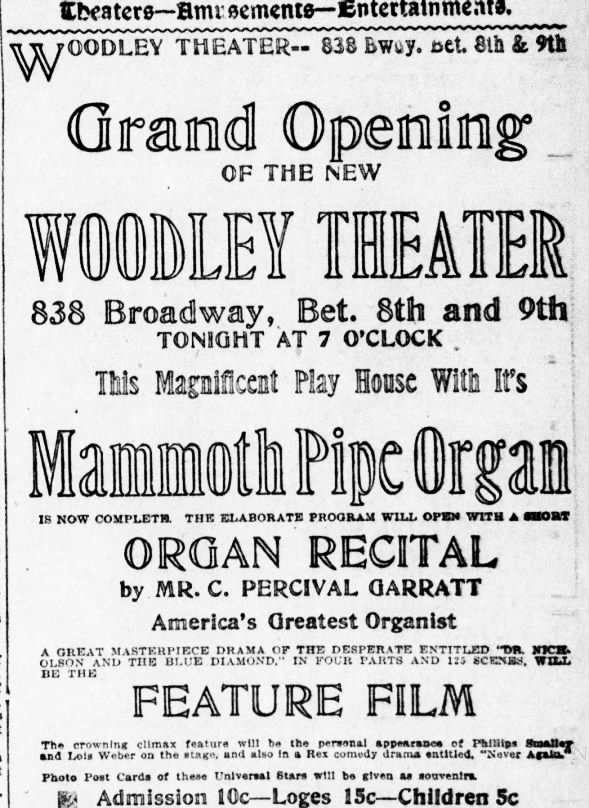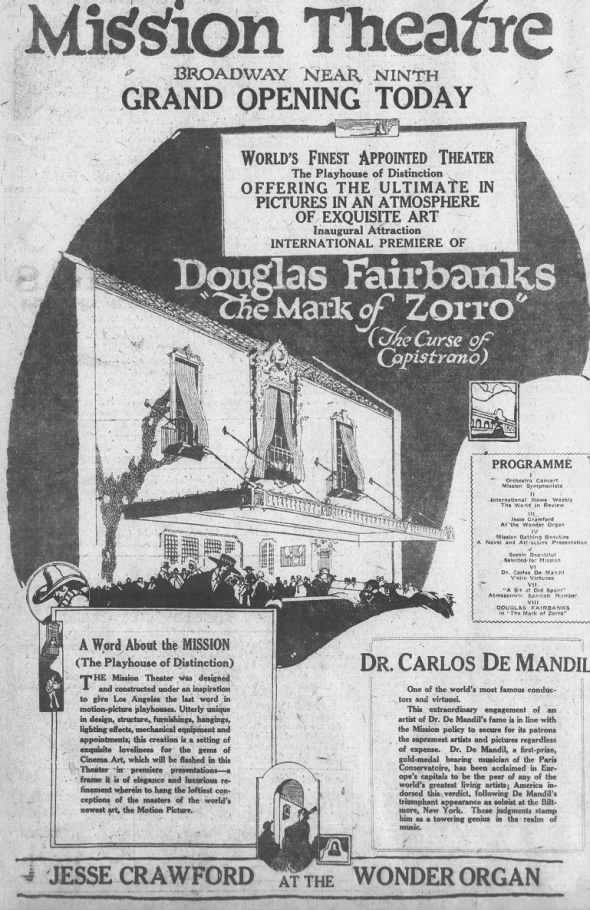
Mission Theatre
838 S. Broadway,
Los Angeles,
CA
90003
![]() 4 people
favorited this theater
4 people
favorited this theater
Additional Info
Architects: H.O. Davis, Frank Meline, Robert Farquhar Train, Robert Edmund Williams
Firms: Train & Williams
Styles: Mission Revival, Spanish Renaissance
Previous Names: Woodley Theatre, Sennett Theatre, Victory Theater
Nearby Theaters
The Woodley Theatre was a movie house in downtown L.A.’s Broadway theatre district. Built for E.W. Woodley, it opened September 27, 1913 with the Danish movie “Dr. Nicholson and the Blue Diamond” starring Holger Reenberg & “Never Again” starring Phillips Smalley & Lois Webber who also appeared ‘in person’ on the stage. It was equipped with a ‘mamouth pipe organ’ which was opened by organist C. Percival Garratt. It was designed by the architectural firm Train & Williams. It was taken over by Mack Sennett and reopened as the Sennett Theatre on November 18, 1917. On September 18, 1918 it was renamed Victory Theater.
It was closed in September 1920 to enable an expansion and extensive remodeling (by architect H.O. Davis and the Frank Meline Company) in a Spanish style. All seating was on a single floor. It was reopened as the Mission Theatre on December 2, 1920 as a motion picture theatre. The opening movie was Douglas Fairbanks in “The Mark of Zorro”. Famed organist Jessie Crawford play the newly installed organ. It did not remain for long, however, as it closed January 18, 1925 and was demolished.
The fourth and current Los Angeles home of the Orpheum Theater Circuit was built on its site, which opened February 15, 1926.
Just login to your account and subscribe to this theater.

Recent comments (view all 17 comments)
I’m trying to find a demolition date but the wording in this article is confusing….I don’t understand what ‘improved with’ means:
(Dec. 2, 1924)
NEW ORPHEUM TO RISE SOON
Work on what is to be the largest and finest theater in the Orpheum chain of showhouses will be started withing the next thirty days at 838 South Broadway at a cost in excess of $1,000,000, it was announced yesterday by Joe Toplitzky, representative for the building syndicate. Bids for the contstruction of the building will be accepted in about three weeks when working plans by Architect G. Albert Langsburg will be completed. Present plans provide for the erection of a twelve-story and basement structure, Class A and of steel frame and reinforced concrete construction, with an auditorium to seat 2300 persons. The site, with a frontage of 138 feet on Broadway and a depth of 148 feet to an alley, is now improved with the Mission Theater and a parking station.
As the term “improvements” refers to any structures, pavements, landscaping, etc. which are on a piece of property, the phrase “improved with” in the article only means that the Mission Theatre and the parking lot (interesting that they call it a parking station) were on the property where the Orpheum was to be built.
That makes sense….I still can’t find anything about the actual demolition.
Here is a December 1918 ad from the LA Times:
http://tinyurl.com/2zrcgu
This is a 1919 ad. I think the address is 838 S. Broadway:
http://tinyurl.com/3xpm6h
Here is an LA Times ad from January 16, 1914:
http://tinyurl.com/672ltz
The May 14, 1913, issue of American Architect and Architecture had a brief item which must have been about this house:
Train & Williams also designed Tally’s Broadway Theatre across the street, opened in 1909, and the Hyman (Garrick) Theatre, up the block at the corner of 8th Street. All three of the theaters on this block that the firm designed had been demolished by the end of the 1920s.Correction: This opened on September 27th, 1913. Grand opening ad posted. Woodley Theater opening Sat, Sep 27, 1913 – 17 · The Los Angeles Times (Los Angeles, California) · Newspapers.com
Woodley Theater opening Sat, Sep 27, 1913 – 17 · The Los Angeles Times (Los Angeles, California) · Newspapers.com
Reopened as Sennett on November 18th, 1917. Grand opening ad posted.
and became the Mission theatre on December 2nd, 1920 Mission theatre opening Thu, Dec 2, 1920 – 3 · The Los Angeles Times (Los Angeles, California) · Newspapers.com
Mission theatre opening Thu, Dec 2, 1920 – 3 · The Los Angeles Times (Los Angeles, California) · Newspapers.com